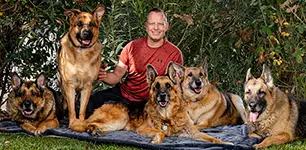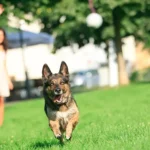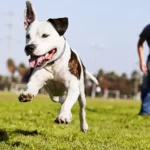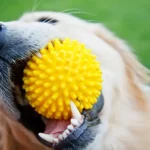
Enrichment is important for most species. We all have experienced boredom. It’s the birthplace of regrettable ideas. Just remember some of the things you came up with as a teenager when you were bored. Some of them probably got you into trouble. But this is not just about the sins of our youth. Boredom and mental stagnation are rarely good things. Once we stop engaging our minds, we are at higher risk of Alzheimer’s Disease and mental decline. Mental stimulation is important for long-term health. This is no different for dogs. Teaching dogs to make good decisions and solve problems doesn’t happen through solitary confinement. Engaging dogs on multiple levels is essential for happiness and well-being.
It is especially important to provide dogs with mental and physical stimulation when they are kept in closer confinements like crates and kennels.
What is Canine Enrichment?
Generally, enrichment is defined as “the action of improving or enhancing the quality or value of something.” Canine enrichment, in particular, is defined as modifying a dog’s environment to improve its quality of life.
Primarily, this means increasing the range or number of normal behaviors and reducing the frequency of abnormal behaviors. The goals are:
- Increasing behavioral diversity.
- Encouraging positive utilization of the environment.
- Increasing the ability of the animal to cope with challenges in a normal way.
Environmental enrichment is important to maintain a dog’s physical and psychological well-being. Lack of enrichment can lead to a range of stress behaviors, including:
- Excessive licking or chewing of their feet, tails, or other body parts, resulting in self-injury.
- Increased or excessive vocalization (e.g., barking).
- Manipulation of enclosure barriers, digging or escaping from the yard.
- Stereotypy (abnormal repetitive behaviors like circling or pacing).
- Coprophagy (eating feces).
- Deliberate self-mutilation.
In contrast, it is also important for a dog to learn to cope with solitude, frustration, and boredom. It is an acquired—and important—skill. Hence, I am not suggesting that dogs must be entertained 24/7. But providing adequate enrichment is about quality of life, and it is essential to strike the right balance.
Types of Canine Enrichment
We generally differentiate six types of enrichment: cognitive, physical, occupational, social, sensory, and nutritional. The different forms of enrichment can be provided separately but are usually combinations. For example, visually open crates can allow a dog to view its surroundings. Increased visual access is both physically and sensorily enriching. Most examples and suggestions provide a combination of enrichment, which is good. Combinations create more complexity and stimulate dogs better mentally.
Cognitive Canine Enrichment
Cognitive enrichment focuses on mental stimulation. All other enrichment types also have mental components, but some activities target cognitive development directly. Examples include:
- Developing predatory hunting skills through play-based learning games.
- Teaching decision-making skills by encouraging dogs to think before acting.
- Psychological resilience to stress and unfamiliar things.
- Building the ability to handle frustration without resorting to fight or flight responses.
Physical Canine Enrichment
Physical enrichment includes altering the quality and complexity of a dog’s living space. Examples include:
- Toys: the most common way people attempt to enrich their dog’s environment is through toys. However, toys must be carefully selected to be safe and enriching to the dog. Typically, toys should be rotated to remain enriching and must be sanitized regularly to remain safe.
- Enclosures: Rotating the enclosures dogs are kept in adds complexity to their environment. Examples include crates, exercise pens, kennels, back ties, and to-person-tethering in rotation. Enclosures can be combined well with rotating toys to increase the complexity further.
- Features: Different types of beds, pillows, Kurandas (raised beds), platforms, structures, and doors (for indoor/outdoor access) add variety to the dog’s environment. These features give dogs more control over their social and physical environment and, depending on the choice, a more comfortable place to rest, a better view of their surroundings, access to the outdoors, or a place to hide.
- Breed-Specific Outlets: For example, sandboxes for digging can allow terriers to engage in normal digging behavior, and sheep herding is a wonderful activity for breeds in the herding group.
- Games: Play allows for the natural expression of biological drives. Ideally, games allow the dog to engage in the aspects of play that matter most to them. Dogs generally enjoy all aspects of the predatory hunting sequence: search, stalk, chase, fight, celebrate and consume. Games teach rules, stimulate dogs mentally and build skill and confidence. In addition, games can be either cooperative (e.g., fetch) or competitive (e.g., tug of war).
Physical enrichment should provide outlets for the positive expression of natural behaviors.
Occupational Canine Enrichment
Occupational enrichment challenges dogs by providing a “job” that encourages physical exercise and mental stimulation. A job can be as simple as paying attention to the owner without losing social connection. Or a job can be as complex as being a service dog to a person with disabilities providing—often life-saving—support. Examples include:
- Dog sports (e.g., GRC, agility, fly balls, dock diving, protection, detection, tracking, and so on)
- Obedience training
- Trick training
- Sheepherding
- Emotional support dog training and service
- Therapy dog training and service
- Service dog training and service
- There are many more
Social Canine Enrichment
Social enrichment facilitates contact with dogs and other species, especially humans. Examples include:
- Supervised group socialization or playgroups
- Unsupervised group socialization (e.g., dog parks or dog beaches)
- Dog walking, if possible, in varying locationss
- Participating in group obedience classes
- Group housing of compatible dogs; social living provides constant complex mental stimulation.
- Cooperative games (e.g., catch and release, aka “fetch”)
- Competitive games (e.g., possession games, aka “tug of war”)
Social enrichment is different from socialization. Social enrichment fulfills dogs’ needs to interact with other dogs and humans through housing and encounters. While socialization is the guided and safe exposure to the environment, the dog lives in.
Sensory Canine Enrichment
Sensory enrichment is about stimulating the different senses of dogs: sight (visual), sound (auditory), touch (kinesthetic), taste (gustatory), and smell (olfactory).
Visual Stimulation
- This can include both stationary and moving images.
- Being able to see inside and outside their environment. For example, seeing inside the kennel environment can provide a sense of security.
- Visually stimulating objects can be placed outside a dog’s run to add interest.
Auditory Stimulation
- Playing music or sound can buffer the noise of kennel environments or other stimulating sounds in home environments and, as a result, provide more calmness. Classic music for companion animals is available for purchase and worth exploring, as studies have shown classical music can reduce stress levels and increase resting and sleeping in dogs.
- Auditory stimulation should not be constant, must be assessed based on the dog’s response, and should be kept low in volume (< 70dB).
- The stimuli must be tailored to the dog’s needs, not the caretakers’. Many sounds pleasing to humans can be displeasing or distressful to dogs.
Kinesthetic Stimulation
- Dogs enjoy all elements of the predatory hunting sequence: search, stalk, chase, fight (i.e., fighting as in overcoming obstacles), celebrate, and consume.
- Play is simulated hunting and taking down prey and is highly stimulating. Great play stimulates all six aspects of hunting.
- Dogs are very physical beings and enjoy all elements of predatory play.
- Games with toys allow us to tap into these aspects when interacting with our dogs.
- This also includes affection. Loving petting can go a long way.
Olfactory Stimulation
- Nose work activities can garner a dog’s interest and are beneficial in mitigating distress.
- Placing lavender-scented cloths in kennels can have a calming effect and reduce the amount of barking and other activities. Diffusers make this easy.
Gustatory Stimulation
- While varying regular food is not advisable to avoid diarrhea and digestive upset, variety with treats can be beneficial.
- Some things taste better than others. Adding taste variety with food puzzles and training can be quite rewarding.
- Consider using different food options: training treats, beef/turkey/chicken jerky, hot dogs, lunch meat, ground beef, and so on.
- Don’t get hung up on ‘people food’ vs. ‘dog food.’ If it’s tasty meat, your dog will like it.
Nutritional Enrichment
Nutritional enrichment is also called feeding enrichment. It encourages the dog to engage in natural foraging and feeding behaviors using food as a reward. Feeding enrichment adds additional activity to the dog’s routine and can help improve a dog’s physical condition.
Natural foraging activities often include scent and search elements for locating food before consumption. A good example is snuffle mats.
Suggestions for Canine Enrichment
Vary your enrichment! Anything can become boring over time. Your dog will lose interest in even the coolest enrichment activity if this is the only thing offered daily, so be creative. You can find our recommendations for toys, puzzles, and so on (incl. links to Amazon) on our Enrichment Toys page.
Stuffed Kong’s
Kongs stuffed with food and frozen provide extended stimulation. Choose high-value stuffing to make it interesting for your dog, and come up with a couple of different options.
- For raw-fed dogs, it is usually easiest to set aside a small portion of their regular meal, mix it in a blender, and stuff the Kong with the mixture.
- For kibble-fed dogs, take some of their kibble, a tablespoon of canned wet food of the same brand, and protein (beef, chicken, lamb, fish, etc.) and mix that in a blender or by hand. Don’t use too much canned food. You want a thick paste.
- For wet-fed dogs, mix their regular canned food in a blender with some of the suggested mix-ins below.
For all dogs, add some mix-ins to make the mixture more tempting and add variety. Good ingredients to add to the blender are canned pumpkin, carrots, broccoli, green beans, spinach, kale, beets, coconut oil, raw eggs with shell, peanut butter (make sure it does NOT contain Xylitol—that is deadly for dogs), cheese, lunch meat, cooked meats or sausages, jerky, marshmallows.
Avoid ingredients your dog is allergic to.
Treat-Dispensing Toys
You can find many treat-dispensing toys from Kong and other companies that can entertain your dog. These are easy to use. You fill them with kibble or treats and let your dog work on getting them out of the toy. Most treats can be accessed by “messing around” with the toys or chewing them. The mental stimulation from these toys is lower than with puzzle feeders. The advantage is most of these toys are widely available and fairly cheap.
Puzzle Feeders
These great games require a dog to move pieces around to access hidden treats they can smell. These are more mentally challenging than treat-dispensing toys and require your dog to think more. These can help slow your dog’s mind down, which is especially helpful for more chaotic and restless dogs. One of the bigger brands in this space is Nina-Ottoson from Sweden. Their products are distributed in the United States by Outward Hound, who subsequently acquired Nina-Ottoson in 2015. These are easy to find on Amazon, and our Enrichment Toys page lists many.
Slow Feeders
These provide mental stimulation. Slow feeders are often just advertised for slowing down eating and helping prevent bloat, but these have another advantage. Slow feeders also make your dog use its nose and eyes while eating and, as such, offer some cognitive benefits and better teach dealing with frustration.
Lick Mats
These are great tools for freezing some wet or raw dog food. They are in the slow feeder category but offer additional sensory enrichment when the food is frozen and offered as a mid-day treat rather than a full meal feeding tool.
Snuffle Mats
Any chance you have to get a dog’s nose involved in eating should be jumped on, and snuffle mats are wonderful. Sprinkling a handful of kibble or tasty treats onto a snuffle mat will keep your dog busy and provide olfactory, cognitive, physical, and nutritional enrichment.
Hide and Seek
Hiding a few items for your dog to find around the house is fun and engaging on multiple levels. You can actively play with your dog, encouraging it to use its nose or hide 2-3 treat-dispensing toys or just regular (favorite) toys around the house when you leave. You can also play this game with scents. Dab some scents (cinnamon, lavender, orange, or other interesting scents) in a few places in the yard to encourage your dog to investigate. Unfamiliar or new smells are always of interest to a dog.
Treats in Ice
If your dog spends time outside, you can leave it a block of ice with some treats frozen inside. Use a plastic bowl or small bucket as a mold. Fill it three-quarters full with water and put it in the freezer. Once the water is slushy, mix in dog kibble, carrot chunks, apple slices, and bits of cooked meat. When frozen, turn it over and pop it out. Give it to your dog outside on a warm day.
Drop-In
When your dog is in its crate, exercise pen, or kennel run, stop by and drop some tasty treats in without otherwise interacting with your dog. Just walk up, say “Hi” if you like, drop the treats in, and walk away. This is a great activity to increase your value to your dog and spark curiosity. You didn’t ask for anything; you just dropped by and delivered something valuable. Who doesn’t like a friend like that? Once your dog considers you valuable, your relationship will thrive like never before. This is especially helpful in the first two weeks after your dog joins the family.
Games
Play is free-style. Games have rules, penalties for breaking the rules, and rewards for winning. Playing well with a dog so they enjoy it, takes a bit of effort to learn but is a lot of fun once you master the basics. It engages your dog on a whole new level by focusing on the aspects of play YOUR dog enjoys the most. There are six general aspects of play: searching, stalking, chasing, fighting, celebrating, and consuming. Games can be competitive (e.g. tug of war) or cooperative (e.g. fetch). If you would like to learn how to become your dog’s best playing partner, you can start by reading our article Play is the Way! or purchase Ivan Balabanov’s training videos Chase and Catch, Possession Games, and Teaching The OUT Command.
Conclusion
Canine enrichment reduces undesirable behaviors resulting from boredom and frustration. It also increases desirable behaviors like problem-solving and positive social interactions.
Enrichment tailored to meet dogs’ needs can help improve many aspects of their health and welfare. It should be incorporated whenever possible, into the standard management practices at kennels, short-term boarding facilities, and homes.
– Garvey et al., 2016
Additional Information
Dogster Article: How to Provide Enrichment Training for Your Dog
Embrace Article: Improving Dog Behavior: Environmental Enrichment
References
Garvey, Stella, Croney, 2016. Implementing Environmental Enrichment for Dogs (PDF) published in Purdue Extension, March 2016, VA-13-W.
Hubrecht, R.C., 1993. A Comparison of Social and Environmental Enrichment Methods for Laboratory Housed Dogs (PDF) published in Applied Animal Behaviour Science, September 1993, Volume 37, Issue 4, Pages 345-361.
Humphrey, N.K., 1976. The Social Function of Intellect (PDF) published in the book Growing Points in Ethology by Cambridge University Press, January 1976, Pages 303-317.
Kogan, L.R., Schoenfeld-Tacher, R., Simon, A.A., 2012. Behavioral Effects of Auditory Stimulation on Kenneled Dogs (PDF) published in Journal of Veterinary Behavior Clinical Applications and Research, September 2012, Volume 7, Issue 5, Pages 268–275.
Mason, G., Clubb, R., Latham, N., Vickery, S., 2007. Why and How Should We Use Environmental Enrichment to Tackle Stereotypic Behaviour? (PDF) published in Applied Animal Behaviour Science, February 2007, Volume 102, Issues 3–4, Pages 163-188.
Newberry, R.C., 1995. Environmental Enrichment: Increasing the Biological Relevance of Captive Environments (PDF) published in Applied Animal Behaviour Science, September 1995, Volume 44, Issues 2–4, Pages 229-243.
Pullen, A.J., Merrill, R.J., Bradshaw, J.W., 2010. Preferences for Toy Types and Presentations in Kennel Housed Dogs (PDF) published in Applied Animal Behaviour Science,Volume 125, Issue 3, Pages 151-156.
Schipper, L.L., Vinke, C.M., Schilder, M.B.H., Spruijt, B.M., 2008. The Effect of Feeding Enrichment Toys on the Behaviour of Kennelled Dogs (Canis Familiaris) (PDF) published in Applied Animal Behaviour Science, November 2008, Volume 114, Issues 1–2, Pages 182-195.
Sales, G., Hubrect, R., Peyvandi, A., Milligan, S., Shield B., 1997. Noise in Dog Kenneling: Is Barking a Welfare Problem for Dogs? published in Applied Animal Behaviour Science, Volume 52, Issues 3–4, April 1997, Pages 321-329.
Tarou, L.R., Bashaw, M.J., 2007. Maximizing the Effectiveness of Environmental Enrichment: Suggestions from the Experimental Analysis of Behavior (PDF) published in Applied Animal Behaviour Science, February 2007, Volume 102, Issues 3–4, Pages 189-204.
Wells, D.L., 2009. Sensory Stimulation as Environmental Enrichment for Captive Animals: A Review (PDF) published in Applied Animal Behaviour Science, April 2009, Volume 118, Issues 1–2, Pages 1-11.
Young, R.J., 2003. Environmental Enrichment for Captive Animals (Amazon) published by Blackwell Science Ltd, 2003.
Play the Audio





